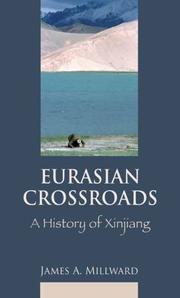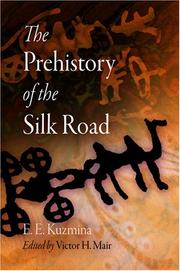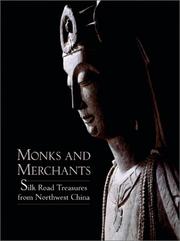| Listing 1 - 10 of 32 | << page >> |
Sort by
|
Book
ISBN: 0719564018 Year: 2004 Publisher: London : Murray,
Abstract | Keywords | Export | Availability | Bookmark
 Loading...
Loading...Choose an application
- Reference Manager
- EndNote
- RefWorks (Direct export to RefWorks)
Book
ISBN: 2857570570 Year: 2000 Publisher: Paris Institut des Hautes Etudes Chinoises du Collège de France
Abstract | Keywords | Export | Availability | Bookmark
 Loading...
Loading...Choose an application
- Reference Manager
- EndNote
- RefWorks (Direct export to RefWorks)
S16A/0200 --- S17/0550 --- Dunhuang, Turfan--Chinese texts --- China: Art and archaeology--Silk route
Book
ISBN: 4916071301 Year: 1998 Publisher: Nara Research Center for Silk roadology
Abstract | Keywords | Export | Availability | Bookmark
 Loading...
Loading...Choose an application
- Reference Manager
- EndNote
- RefWorks (Direct export to RefWorks)
S17/0550 --- Silk Road --- China: Art and archaeology--Silk route. --- Antiquities --- Japanese --- China: Art and archaeology--Silk route

ISBN: 9780231139243 0231139241 Year: 2007 Publisher: New York (N.Y.) Columbia University Press
Abstract | Keywords | Export | Availability | Bookmark
 Loading...
Loading...Choose an application
- Reference Manager
- EndNote
- RefWorks (Direct export to RefWorks)
Xinjiang Uygur Zizhiqu (China) --- Xinjiang (Chine) --- History. --- Histoire --- S17/0550 --- S25/0500 --- China: Art and archaeology--Silk route --- Xinjiang--History (Uigurs come here)
Book
ISBN: 4916071298 Year: 1998 Publisher: Nara Research Center for Silk roadology
Abstract | Keywords | Export | Availability | Bookmark
 Loading...
Loading...Choose an application
- Reference Manager
- EndNote
- RefWorks (Direct export to RefWorks)
Tadmur (Syria) --- Antiquities. --- S17/0550 --- China: Art and archaeology--Silk route --- Tudmur (Syria) --- Tadmor (Syria) --- Tedmor (Syria) --- Palmyra (Syria) --- Palmyre (Syria) --- Palmyra

ISBN: 9780812240412 0812240413 1336015160 0812292332 Year: 2008 Publisher: Philadelphia University of Pennsylvania Press
Abstract | Keywords | Export | Availability | Bookmark
 Loading...
Loading...Choose an application
- Reference Manager
- EndNote
- RefWorks (Direct export to RefWorks)
In ancient and medieval times, the Silk Road was of great importance to the transport of peoples, goods, and ideas between the East and the West. A vast network of trade routes, it connected the diverse geographies and populations of China, the Eurasian Steppe, Central Asia, India, Western Asia, and Europe. Although its main use was for importing silk from China, traders moving in the opposite direction carried to China jewelry, glassware, and other exotic goods from the Mediterranean, jade from Khotan, and horses and furs from the nomads of the Steppe. In both directions, technology and ideologies were transmitted. The Silk Road brought together the achievements of the different peoples of Eurasia to advance the Old World as a whole.The majority of the Silk Road routes passed through the Eurasian Steppe, whose nomadic people were participants and mediators in its economic and cultural exchanges. Until now, the origins of these routes and relationships have not been examined in great detail. In The Prehistory of the Silk Road, E. E. Kuzmina, renowned Russian archaeologist, looks at the history of this crucial area before the formal establishment of Silk Road trade and diplomacy. From the late Neolithic period to the early Bronze Age, Kuzmina traces the evolution of the material culture of the Steppe and the contact between civilizations that proved critical to the development of the widespread trade that would follow, including nomadic migrations, the domestication and use of the horse and the camel, and the spread of wheeled transport.The Prehistory of the Silk Road combines detailed research in archaeology with evidence from physical anthropology, linguistics, and other fields, incorporating both primary and secondary sources from a range of languages, including a vast accumulation of Russian-language scholarship largely untapped in the West. The book is complemented by an extensive bibliography that will be of great use to scholars.
S17/0211 --- S17/0550 --- China: Art and archaeology--Archaeology: Prehistory --- China: Art and archaeology--Silk route --- Bronze age --- Asia, Central --- Silk Road --- Antiquities. --- Civilization --- Silk Route --- African Studies. --- Anthropology. --- Archaeology. --- Asian Studies. --- Folklore. --- Linguistics. --- Middle Eastern Studies.
Book
ISBN: 906966092X Year: 1994 Publisher: Brugge Van de Wiele
Abstract | Keywords | Export | Availability | Bookmark
 Loading...
Loading...Choose an application
- Reference Manager
- EndNote
- RefWorks (Direct export to RefWorks)
ASE Eastern & Central Asia --- Asia --- Eastern & Central Asia --- S17/0550 --- S03/0523 --- China: Art and archaeology--Silk route --- China: Geography, description and travel--Travels: since 1989 --- China --- Description and travel. --- Art and archaeology --- Silk route.

ISBN: 0810934787 0878480897 9780810934788 9780878480890 Year: 2001 Publisher: New York: Abrams,
Abstract | Keywords | Export | Availability | Bookmark
 Loading...
Loading...Choose an application
- Reference Manager
- EndNote
- RefWorks (Direct export to RefWorks)
Stunning works in precious metals, glass, and stone--many recently excavated and virtually unknown outside China--shed new light on a pivotal epoch in Chinese history. From the 4th through 7th century, monks and merchants freely traveled along the fabled Silk Road, linking China with the west, propagating Buddhism, and purveying exotic goods and artifacts that fundamentally transformed Chinese culture and society. This sumptuous volume, the first to explore the magnificent treasures and sites of China's northwest section of the Silk Road, accompanies an exhibition at the Asia Society in New York. The text by an international team of scholars illuminates the importance of the region in this period of fertile cross-cultural exchanges between Eastern and Western Asia.
China, Northwest --- Silk Road --- Antiquities --- monks --- merchants --- zijderoute --- Northwest China --- monks [people] --- S17/2125 --- S17/0550 --- China: Art and archaeology--Musea and exhibitions: USA --- China: Art and archaeology--Silk route --- China, Northwest - Antiquities --- Silk Road - Antiquities
Book
ISBN: 2711830683 Year: 1995 Publisher: Paris : Éditions de la Réunion des musées nationaux,
Abstract | Keywords | Export | Availability | Bookmark
 Loading...
Loading...Choose an application
- Reference Manager
- EndNote
- RefWorks (Direct export to RefWorks)
Aziatische kunst --- archeologie --- boeddhisme --- kunstgeschiedenis (algemeen) --- Azië --- S17/0500 --- S17/0550 --- China: Art and archaeology--Buddhist art: general --- China: Art and archaeology--Silk route --- Exhibitions --- geschiedenis en archeologie --- Azië. --- wereldtentoonstelling 1958 (Brussel) --- Indiaanse kunst --- volkskunst --- schilderkunst --- sculptuur --- 20ste eeuw. --- Amerika.
Book
ISBN: 3905014173 Year: 2001 Volume: 10 Publisher: Riggesberg Abegg-Stiftung
Abstract | Keywords | Export | Availability | Bookmark
 Loading...
Loading...Choose an application
- Reference Manager
- EndNote
- RefWorks (Direct export to RefWorks)
Manufacturing technologies --- textile materials --- Archeology --- anno 100-199 --- Antiquity --- Central Asia --- Textile fabrics --- Textiles et tissus --- Exhibitions --- Expositions --- Asia, Central --- Asie centrale --- Antiquities --- Antiquités --- S17/0550 --- S17/1300 --- China: Art and archaeology--Silk route --- China: Art and archaeology--Textile, tapestries, embroideries, rugs, fashion --- Antiquités --- Applied arts. Arts and crafts
| Listing 1 - 10 of 32 | << page >> |
Sort by
|

 Search
Search Feedback
Feedback About UniCat
About UniCat  Help
Help News
News